
A | B | C | D | E | F | G | H | CH | I | J | K | L | M | N | O | P | Q | R | S | T | U | V | W | X | Y | Z | 0 | 1 | 2 | 3 | 4 | 5 | 6 | 7 | 8 | 9
It has been suggested that this article should be split into articles titled List of current Brigham Young University buildings and List of former Brigham Young University buildings. (discuss) (September 2023) |

This list of Brigham Young University buildings catalogs the current and no-longer-existent structures of Brigham Young University (BYU), a private, coeducational research university owned by the Church of Jesus Christ of Latter-day Saints (LDS Church) located in Provo, Utah, United States. BYU's buildings exceed 300 in number and cover the university's 560 acres (2.3 km2) of property.
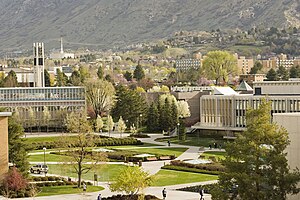
Academic facilities
| Building | Abbr. | Image | Sq. Ft. | Yr. Occ. | Notes | References |
|---|---|---|---|---|---|---|
| Benson (Ezra Taft) Building | BNSN | 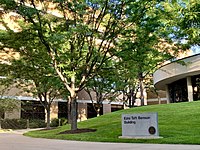
|
191,325 | 1995 | Building is a science building, primarily housing the offices and classrooms of the chemistry department. | [1][2][3] |
| Brimhall (George H.) Building | BRMB | 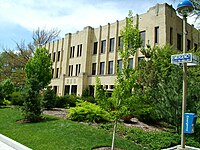
|
40,276 | 1918 | Originally built as a one-story building. It housed the Student Army Training Corps as its first function, since it was completed during World War I. It was then called the mechanical arts building. After the SATC was no longer on BYU campus the building was used by the department of mechanical arts for such things as black smithing and woodworking classes. In 1935 the second and third stories were added and the building was renamed in honor of George H. Brimhall, who had been BYU president when it was built. Another renovation was done in 1984 which expanded the structure. At this point the building housed several programs of the Department of Visual Arts. In 2004 the building underwent significant renovation and then became the location of BYU's School of Communications. | [4][2][5] |
| BYU Conference Center | CONF | 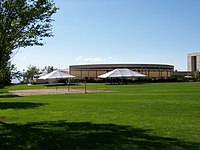
|
52,033 | 1982 | The Brigham Young University Conference Center (CONF) is located on the northeastern part of the BYU campus, with great views of the nearby mountains, and shares a lobby with the Harman Continuing Education Building (HCEB). The Conference Center is primarily used for university sponsored conferences and events, but is also available for family events, and may be utilized as a space to have an off-site meeting or meal for a business or other organization.
The BYU Conference Center has two main levels with available conference space||[4][2][6] | |
| Centennial Carillon Tower | BELL | 
|
1,418 | 1975 | 152 feet tall with 52 bells | [4][2][7] |
| Chemicals Management Building | CMB | 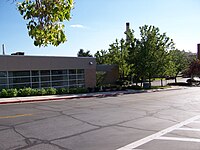
|
6,870 | 1993 | [4][2] | |
| Clark (Herald R.) Building | HRCB | 
|
30,879 | 1952 (renovated 1985) | Originally known as the Student Service Center, one of the main functions of this building when it was built was housing the BYU bookstore, a function it continued until the bookstore relocated to its current location in the Wilkinson Student Center.[8] The Clark building also from very early on housed various academic departments. For example, until about 1965 this was the location of the journalism department of BYU. The building is currently the headquarters of the David M. Kennedy Center for International Studies. | [4][2][9][10] |
| Clark (J. Reuben) Building (Law School) | JRCB | 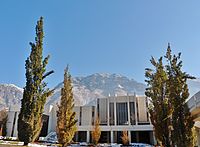
|
174,970 | 1975 (renovated 1996) | [4][2] | |
| Clyde (W.W.) Engineering Building | CB | 
|
203,575 | 1973 | The Clyde Building houses the College of Engineering and Technology. More than 40 percent of the total floor space is used for laboratory instruction and research in electrical, chemical, civil, and mechanical engineering, as well as for engineering analysis and interdepartmental functions. It also houses a solid-state laboratory, many large study rooms, and facilities for environmental, high-pressure, saline water, thermodynamics, nuclear, and transport processes research. | [4][2][11] |
| Crabtree (Roland A.) Technology Building | CTB | 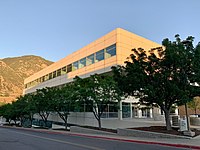
|
99,448 | 1985 | The Crabtree Building houses the School of Technology and the Mechanical Engineering Department, as well as offices, classrooms, laboratories, and a large study area.[12] | [4][2] |
| Ellsworth (Leo B.) Building | ELLB | 74,557 | 1980 | [4][2] | ||
| Engineering Building | EB | 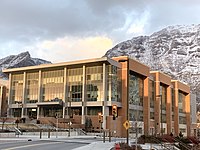
|
184,343 | 2018 | ||
| Engineering Projects Lab | EPL | 1970 | [4][2] | |||
| Engineering Research Lab | ERL | 
|
16,331 | 2018 | ||
| Eyring (Carl F.) Science Center | ESC | 
|
187,590 | 1950 (renovated 1997) | Named after Carl F. Eyring who was a BYU professor. This building contains the Royden G. Derrick Planetarium. Eyring was an acoustical physicist and dean of BYU's College of Arts and Sciences, the predecessor of about five of the current colleges. | [4][2][13][14] |
| Former Presidents' Home | FPH | 
|
5,616 | 1925 (renovated 1989) | This is the location of the offices of BYU's Graduate Studies. | [4][2][15] |
| Grant (Heber J.) Building | HGB | 
|
26,463 | 1925 (renovated 1982) | The Heber J. Grant Building was originally the BYU Library. After the library moved to its current location at the Harold B. Lee Library the building has served many functions. For a time it housed the BYU Honors Program. It was also the first location of the BYU Faculty Center. Currently it houses the BYU Testing Center, the Religious Studies Center and also has a few classrooms. | [4][2][16][17] |
| Harman (Caroline Hemenway) Building | HCEB | 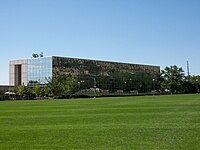
|
142,553 | 1982 (renovated 2018) | Named after the stepmother of Pete Harman, the developer of the KFC franchising system. He was a major financial contributor to the original building's construction. Home to the BYU Division of Continuing Education. Approximately 100,000 square feet of space was added upon completion of the 2018 renovations. It shares a lobby with the BYU Conference Center. | [4][2][18] |
| Johnson (Doran) House East | JNEH | 
|
1965 | [4][2] | ||
| Kimball (Spencer W.) Tower | KMBL | 
|
133,849 | 1981 | Named after Spencer W. Kimball, the KMBL is the tallest building on campus and the third tallest building in Provo. It stands approximately 160 feet (49 m) tall (12 stories), and houses several departments and centers, including Political Science, Neuroscience, Nursing and Geography departments, as well as classrooms, faculty offices, an auditorium, and a large computer lab. | [4][2][19][20] |
| Knight (Jesse) Building | JKB | 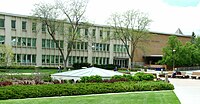
|
139,164 | 1960 (renovated 2007) | Named after Amanda Knight's husband, Jesse Knight. When it was first built the Jesse Knight Building was the business building. It was significantly expanded in 1966. After the Tanner Building was built the Jesse Knight Building became the location of the College of Humanities. However, with the completion of the new Joseph F. Smith Building in 2005 some humanities functions were shifted out of the Jesse Knight Building, and some non-humanities institutions have moved into the building, so it is no longer known as the Jesse Knight Humanities Building (JKHB) as it was for many years. Currently the Jesse Knight Building is the location of the BYU Police, Office of First-Year Experience, Human Resource Development, the Visual Arts department (in the BYU College of Fine Arts and Communications), the English Writing Center, the Humanities Publications Center, School of Management computer laboratories, and classrooms. | [4][2] |
| Lee (Harold B.) Library | HBLL | 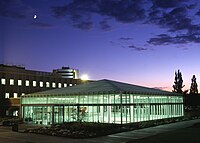
|
715,983 | 1961 (renovated 1999) | The Lee Library, completed in 1961, was originally named the J. Reuben Clark Library, but when BYU named its law school after President Clark, the library name was changed to honor LDS Church President Harold B. Lee. Included in the library are archives and manuscript collections of Western American history, historical film and music collections, and a learning resource center offering all types of media. The library's LDS family history facility is the second-largest in the world. With more than three million volumes in the university's library collection, and nearly half of those books in storage off-campus, an addition to BYU's large library was long overdue. The 234,000-square-foot (21,700 m2) addition to the library opened in the fall of 1999. | [4][2][11] |
| Life Sciences Building | LSB | 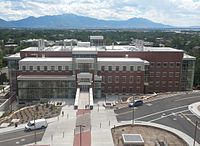
|
269,936 | 2014 | The building houses the College of Life Sciences and five of its seven departments. | [21] |
| Life Sciences Greenhouses | LSGH | 21,021 | 2011 | The Life Sciences Greenhouses were built to replace the greenhouses by the Cluff Building. They are located adjacent to Kiwanis Park on the east side of Provo at 1000 East 820 North. | [22][23] | |
| Life Sciences Greenhouses Storage Shed #1 | LSG1 | 784 | 2011 | [23] | ||
| Life Sciences Greenhouses Storage Shed #2 | LSG2 | 200 | 2011 | [23] | ||
| Life Sciences Horse Stable | P30L | 1992 | [4][2] | |||
| Maeser (Karl G.) Building | MSRB | 
|
19,255 | 1911 (renovated 1985) | Named after Karl G. Maeser, the MSRB currently houses a lecture hall and the administrative offices for the university's Honors Program. | [4][2][24] |
| Martin (Thomas L.) Building | MARB | 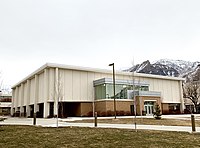
|
43,717 | 1969 (renovated 2000) | Mainly consists of lecture halls. This includes four that have seating capacity of 254 students. The building is also used extensively for BYU LDS Wards to meet, since such sized rooms are ideal for sacrament meeting at least in area. This building, with its primary focus on science and liberal arts classes, rarely houses fine arts classes and has multiple pianos in it. | [4][2][25] |
| McKay (David O.) Building | MCKB | 
|
80,939 | 1954 (renovated 2003) | The David O. McKay building is named for David O. McKay, a Latter-day Saint educator and president of the church when it was built. It houses most of the offices and many classrooms of the David O. McKay School of Education. When initially built, the English, Modern Languages, History and Political Science Departments were also located here, but they all later moved to other buildings as the campus grew. | [4][2][26][27] |
| Music Building | MB | 170,000 | 2023 | The MB houses the academic and performance spaces for the BYU School of Music. It contains numerous practice and performance rooms, including a 1,000-seat vineyard-style performance hall. | [28] | |
| Nicholes (Joseph K.) Building (Chemical Stores) | NICB | 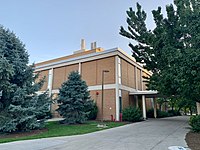
|
23,920 | 1971 | The NICB predates the much larger Ezra Taft Benson Building to which it is attached by about 25 years. It is currently used as the chemical storehouse for many of BYU's STEM programs. | [4][2] |
| Risk Management Building | RMB | 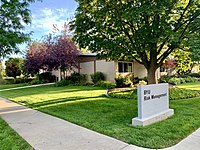
|
6,638 | 1964 | Formerly known as B49, BYU's Risk Management Department moved into this building following the demolition of the Harvey Fletcher Building in 2019. The RMB was originally built as the Herbarium and Range Science Lab of BYU. It later housed the Ezra Taft Benson Agriculture and Food Institute. However, in January 2008, it was decided to disassociate the Benson Institute from BYU and make it an independent operation of the Church of Jesus Christ of Latter-day Saints and its welfare system, because the Institute had a practical instead of an academic purpose. The Benson Institute moved to the LDS Church Office Building and the Neal A. Maxwell Institute for Religious Scholarship moved into this building, vacating its former home just west of the McDonald Building. Following Risk Management's move into the RMB, the Maxwell Institute moved into temporary offices in the Clyde Engineering Building to await a permanent home in the new West View Building. | [29] |
| Smith (Joseph F.) Building | JFSB | 
|
317,552 | 2005 | Named after Joseph F. Smith, the JFSB is home to the History, Sociology, Social Work, and the School of Family Life departments, as well as many research centers and institutes within the College of Family, Home, and Social Sciences. The building is also shared with the College of Humanities. | [4][2][30] |
| Smith (Joseph) Building | JSB | 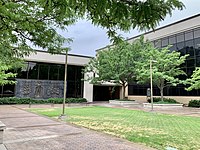 |
73,815 | 1991 | The Joseph Smith Building is named after Joseph Smith, the founder of the Church of Jesus Christ of Latter-day Saints. It is the home to BYU's College of Religion. It contains most of the offices of religion faculty as well as a large number of class rooms where religion classes are held. It also has a very large lecture hall that seats about 1,000 people and is used for large classes. | [4][2] |
| Snell (William H.) Building | SNLB | 
|
37,796 | 1959 (renovated 2010) | Originally home of the College of Industrial and Technical Education. This college was merged into the College of Engineering and Technology in the 1970s and this building was one of the buildings used by the new college. | [4][2][31] |
| Talmage (James E.) Math Sciences/Computer Building | TMCB | 
|
158,696 | 1971 (renovated 1990) | Named for LDS Apostle and scientist James E. Talmage. When it was built it housed the Computer Science, Math and Statistics departments. It also housed The BYU Research Center and the Office of Institutional Research. It had 25 classrooms as well as its offices and computer rooms. At the time of construction it had 61,000 square feet (5,700 m2). A large addition was later built onto the west end of the building. | [4][2][32] |
| Tanner (N. Eldon) Building | TNRB | 
|
224,901 | 1983 (addition built 2008) | Houses the Marriott School of Business | [4][2] |
| Taylor (John) Building (Comprehensive Clinic) | TLRB | 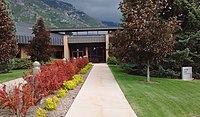
|
34,549 | 1980 | This building has been the comprehensive clinic from its first use. It was built to provide a single location for those in the human services discipline, and provides marriage, family, child, adolescent, and individual therapy and counseling as well as doing various forms of diagnostic testing. It also houses the Communication Disorders Department and LDS Family Services. | [4][2][33] |
| University Parkway Center | UPC | 
|
48,601 | 1999 | This building houses the English Language Center for foreign students learning English as a second language. | [4][2] |
| Weather Station | WTHR | 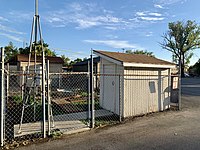
|
42 | 1980 | Situated directly southwest of the Risk Management Building (B49). | [4][2] |
| West View Building | WVB | 
|
2020 | Plans were announced in November 2018 to demolish and replace the Faculty Office Building (FOB) with the West View Building. The WVB has several classrooms and houses the offices for the Department of Economics, the Department of Statistics, and the Neal A. Maxwell Center for Religious Scholarship. | [34] | |
| Wells (Daniel H.) Building (ROTC) | ROTC | 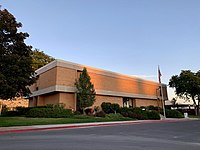
|
15,188 | 1968 | Named after Daniel H. Wells, an apostle of the Church of Jesus Christ of Latter-day Saints and the third mayor of Salt Lake City. | [4][2] |
Administrative buildings
| Building | Abbr. | Image | Yr. Occ. | Notes | References |
|---|---|---|---|---|---|
| Brewster (Sam F.) Building | BRWB | 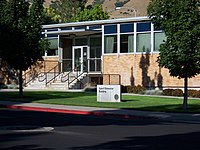 |
1962 | [4][2] | |
| Bullock House | BULH | 1996 | [4][2] | ||
| University Guest House | GH | 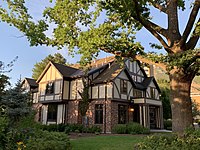
|
2014 | The 5,000 square-foot guest house was built with the intention of giving campus visitors closer access to campus and students. It provides many amenities to university guests similar to what a hotel provides. The house was designed to match the style of the neighboring historic Former Presidents' home. | [35] |
| Hinckley (Gordon B.) Alumni & Visitors Center | HC |  |
2007 | Named after Gordon B. Hinckley, the fifteenth President of the Church of Jesus Christ of Latter-day Saints, the Gordon B. Hinckley Alumni and Visitors Center serves as the gateway to campus and houses the Alumni Association, Guest Relations and Public Affairs, Annual Giving and School Relations. | [4][2][36] |
| Information Technology Building | ITB | 2009 | The Information Technology Building is a three-story building located west of the main campus between Canyon Road and University Avenue. It houses the majority of the employees working for the Office of Information Technology. | [4][2] |
